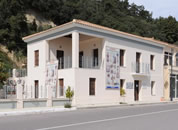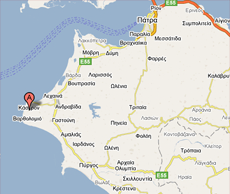
Home Katakolon Marina Weather Contact
new
Kyllini Baths

Developed - S.E.O by ATG Network
© 2006 - 2011 Katakolon.org | About Us | Legal Notices

Loutra Kyllini or Linzi is an area of exceptional natural beauty. It is at a 40 min distance from Katakolon Port. The thermal springs are between two lines of hills (mostly sandy) which format a valley spreading up to the sea for about 330 metres. The area of the Baths shows dense vegetation with old trees, mainly eucalyptus that were planted at 1890-1892, relocated from France with the help of the company SPAP that exploited the Baths at the time.
Loutra Kyllini was an independent settlement till 1912. After the recognition of the Municipalities and Townships with which the village Kastro was recognised as a Township, simultaneously Loutra became a part of the Kastro Township. After the adjustment of the Kapodistrian law 2539/1997 the Municipal Department of Kastro constituted a united unit of the newly made Municipality of Kastro – Killini. The name Loutra Killinis exists still in order to avoid confusion, since it was already known under that name.
Killini Baths are known from ancient times for their thermal springs where their water, vapours and mud heal arthritis, asthma and skin conditions. An explanation is that the word Litzi meant bath in Latin. Another is it means “Hades’ mouth”, where the Litzeans (demons) appeared. During the Ottoman Rule there was a bandit named Litzis, who probably took his name from that demons. In 1880, under Trikoupis premiership, the Baths were given to the Railroad Organisation of Peloponnese (SPAP), who exploited for the first time the thermal springs by building a hotel and a spa.
The thermal springs were abandoned for centuries and in 1890 – under Trikoupis premiership – the exploitation begun by the company SPAP for 50 years. At that time was the railway line to the Baths constructed, with Kavasila as a starting point. The line worked till 1940 and was destroyed during the German occupation.
The company SPAP, exploiting the Baths, constructed a spa with a big waiting room, 50 marble bathtubs, inhaling treatment and cleaning nose and ears, spraying the larynx, hotels and special guesthouses, with apartments for rental, buying, a park, flower gardens etc. During the German occupation and the civil war, the facilities were destroyed and only in 1951 EOT (Greek Tourism Organisation) recreated the spa, hotels and a camping in the area. Since 1998 the Bath area was rented to Nikolaos Daskalantonakis for 46 years and a spa and a luxury hotel work now. The kinds of treatments taking place in the Baths are:
* Drinking treatment
* Rhine wash
* Individual Inhaling
* Group Inhaling
* Spa
* Mud treatment
The Baths are considered to cure skin conditions, rheumatisms, neuralgias, migraines, face pains as long as conditions of the bones and the kinetic system.
Loutra Kyllini was an independent settlement till 1912. After the recognition of the Municipalities and Townships with which the village Kastro was recognised as a Township, simultaneously Loutra became a part of the Kastro Township. After the adjustment of the Kapodistrian law 2539/1997 the Municipal Department of Kastro constituted a united unit of the newly made Municipality of Kastro – Killini. The name Loutra Killinis exists still in order to avoid confusion, since it was already known under that name.
Killini Baths are known from ancient times for their thermal springs where their water, vapours and mud heal arthritis, asthma and skin conditions. An explanation is that the word Litzi meant bath in Latin. Another is it means “Hades’ mouth”, where the Litzeans (demons) appeared. During the Ottoman Rule there was a bandit named Litzis, who probably took his name from that demons. In 1880, under Trikoupis premiership, the Baths were given to the Railroad Organisation of Peloponnese (SPAP), who exploited for the first time the thermal springs by building a hotel and a spa.
The thermal springs were abandoned for centuries and in 1890 – under Trikoupis premiership – the exploitation begun by the company SPAP for 50 years. At that time was the railway line to the Baths constructed, with Kavasila as a starting point. The line worked till 1940 and was destroyed during the German occupation.
The company SPAP, exploiting the Baths, constructed a spa with a big waiting room, 50 marble bathtubs, inhaling treatment and cleaning nose and ears, spraying the larynx, hotels and special guesthouses, with apartments for rental, buying, a park, flower gardens etc. During the German occupation and the civil war, the facilities were destroyed and only in 1951 EOT (Greek Tourism Organisation) recreated the spa, hotels and a camping in the area. Since 1998 the Bath area was rented to Nikolaos Daskalantonakis for 46 years and a spa and a luxury hotel work now. The kinds of treatments taking place in the Baths are:
* Drinking treatment
* Rhine wash
* Individual Inhaling
* Group Inhaling
* Spa
* Mud treatment
The Baths are considered to cure skin conditions, rheumatisms, neuralgias, migraines, face pains as long as conditions of the bones and the kinetic system.

Map
